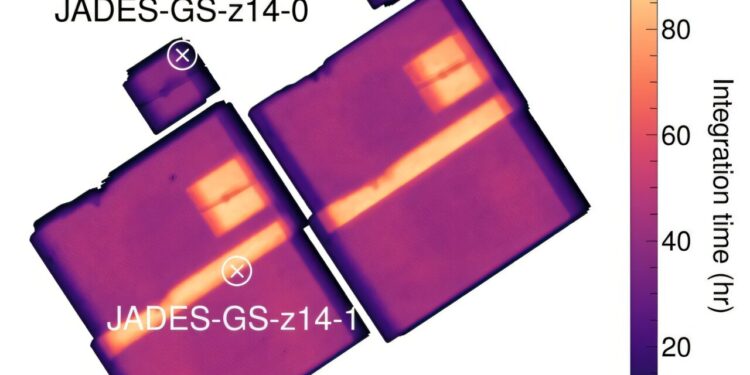Timping map of integration of the parallel field of Jades Deep Miri / F770W. The crosses with circles mark the locations of Jades-GS-Z14-1 and Jades-GS-Z14-0. Jades-GS-Z14-1 is located in the two-point overlapping region and therefore has an integrated source of 70.7 hours. Credit: arxiv (2025). DOI: 10.48550 / Arxiv.2507.22858
Using the James Webb space telescope (JWST), an international team of astronomers observed a slight distant galaxy designated Jades-GS-Z14-1. Results of the observation campaign, published on July 30 on the arxiv The prior server provides more information on the nature and properties of this galaxy.
Launched in space in 2021, JWST is designed to find and study the most distant galaxies, providing an overview of the start of the universe. It allows the detection of galaxies in the first 500 million years after the Big Bang.
One of these first galaxies is Jades-GS-Z14-1-The galaxy confirmed by the lowest spectroscopy, with a red lag of about 14.0. The galaxy has an absolute ultraviolet magnitude of -19.0 and is relatively compact because its half-light radius does not exceed 520 light years. Previous observations of Jades-GS-Z14-1 have found that it has a mass of approximately 100 million solar masses and a star formation rate (SFR) at a level of approximately two solar masses per year.
A group of astronomers led by Zihao Wu of the Harvard-Smithsonian Center for Astrophysics (CFA) in Cambridge, Massachusetts, used JWST to carry out deep imaging and a spectroscopy of Jades-GS-Z14-1. The observations were made with the Middle Infrared Instrument (MIRI) of JWST, the near Infrared (NICCAC) and the near infrared spectrograph (NIRSPEC), as part of the deep extragalactic survey advanced by JWST (Jades).
“We present extremely deep JWST observations of Jades-GS-Z14-1, the lowest galaxy confirmed by spectroscopy to Redshift Z ≈ 14 to date. This object has received an unprecedented 70.7-hour nircam photometry, 56 hours of 16-band spectra, and 56 hours of research in the NIRSEC / Prism Spectroscopy Jades, “Paper in the document.
JWST observations only marginally detected Jades-GS-Z14-1 in the Miri / F770W band. In addition, the study did not lead to any significant detection of the ultraviolet rest frames with rest frames in the prism spectroscopy Nirspec deep, despite extremely deep observations.
Observations show that Jades-GS-Z14-1 has a physical radius of less than 163 light years. The stellar mass of the galaxy has proven to be around 40 million solar masses, and its star formation rate was confirmed to be around two solar masses per year.
By analyzing the history of the training of the stars of Jades-GS-Z14-1, the WU team found that its SFR has experienced a sharp increase in the last 10 million years. During this increase, the galaxy had an average rate of star formation of 2.3 per year and formed almost 70% of its stellar mass.
Astronomers have stressed that Jades-GS-Z14-1 shows no prominent ultraviolet metal emission line. This, with the formation of intense stars of the galaxy, suggests a metallicity in the gaseous phase of less than 10% solar and potentially a high escape fraction of ionizing photons.
The authors of the article concluded that their results could help us better understand the evolution of the first galaxies.
“The weakness of the metal emission lines suggests that the strong nebular lines are not omnipresent in the first galaxies. These results underline the diversity of the properties of early galaxy and provide key constraints on the enrichment of metals, the formation of stars and ionizing conditions during the first 300 million years after the Big Bang”, wrote scientists.
Written for you by our author Tomasz Nowakowski, edited by Stephanie Baum, and verified and examined by Andrew Zinin – This article is the result of careful human work. We are counting on readers like you to keep independent scientific journalism alive. If this report matters to you, please consider a donation (especially monthly). You will get a without advertising count as a thank you.
More information:
Zihao Wu et al, Jades-GS-Z14-1: a compact and weak galaxy at $ z \ Approx arxiv (2025). DOI: 10.48550 / Arxiv.2507.22858
Newspaper information:
arxiv
© 2025 Science X Network
Quote: JWST observations highlighted the nature of a distant galaxy (2025, August 5) recovered on August 5, 2025 from
This document is subject to copyright. In addition to any fair program for private or research purposes, no part can be reproduced without written authorization. The content is provided only for information purposes.



